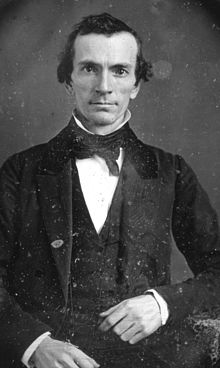
Back Oliver Cowdery BCL Oliver Cowdery German Oliver Cowdery Esperanto Oliver Cowdery Spanish Oliver Cowdery Finnish Oliver Cowdery French Oliver Cowdery Galician Oliver Cowdery IO Oliver Cowdery Portuguese Каудери, Оливер Russian
| Oliver Cowdery | |
|---|---|
 Daguerreotype of Oliver Cowdery found in the Library of Congress, taken in the 1840s by James Presley Ball | |
| Assistant Counselor in the First Presidency | |
| September 3, 1837 – April 11, 1838 | |
| End reason | Resignation / Excommunication |
| Assistant President of the Church | |
| December 5, 1834 – April 11, 1838 | |
| End reason | Resignation / Excommunication |
| Second Elder of the Church | |
| April 6, 1830 – December 5, 1834 | |
| End reason | Called as Assistant President of the Church |
| Latter Day Saint Apostle | |
| 1829 (aged 22) – April 12, 1838 | |
| Reason | Restoration of priesthood |
| End reason | Resignation / Excommunication |
| Reorganization at end of term | No apostles immediately ordained[1] |
| Personal details | |
| Born | Oliver H. P. Cowdery October 3, 1806 Wells, Vermont, U.S. |
| Died | March 3, 1850 (aged 43) Richmond, Missouri, U.S. |
| Resting place | Richmond Pioneer Cemetery, Missouri, U.S. 39°17′6.76″N 93°58′34.93″W / 39.2852111°N 93.9763694°W |
| Spouse(s) | Elizabeth Ann Whitmer |
| Children | 6 |
| Signature | |
 | |
Oliver H. P. Cowdery[2] (October 3, 1806 – March 3, 1850) was an American religious leader who, with Joseph Smith, was an important participant in the formative period of the Latter Day Saint movement between 1829 and 1836. He was the first baptized Latter Day Saint, one of the Three Witnesses to the Book of Mormon's golden plates, one of the first Latter Day Saint apostles and the Assistant President of the Church.
Cowdery's relationship with Joseph Smith and the church's leadership began to deteriorate in the mid-1830s. He was excommunicated in 1838 along with several other prominent Missouri church leaders on allegations of misusing church property amid tense relations between them and Smith.[3]
After his excommunication, Cowdery moved to Wisconsin, where he practiced law and became involved in local politics. Cowdery became a Methodist, but later returned to the Latter Day Saint movement and was rebaptized into the Church of Jesus Christ of Latter-day Saints (LDS Church) in 1848.
- ^ On January 24, 1841, Hyrum Smith was ordained and replaced Cowdery as Assistant President of the Church.
- ^ Prior to the winter of 1830–31, Cowdery generally signed his name "Oliver H P Cowdery", likely representing the names Hazard and Perry. Oliver Hazard Perry was a recent war hero who decisively defeated the British on Lake Erie in the War of 1812. Criticism of his use of this "pretentious moniker" by the Palmyra Reflector (June 1, 1830) probably influenced Cowdery to abandon his temporary usage of the initials. See Ryan N. Cramer, "The Elusive Middle Names of Oliver H. P. Cowdery" John Whitmer Historical Association Journal 42, No. 1 (2022), 79-87 .
- ^ Marquardt 2005, p. 463; Remini 2002, p. 128; Quinn 1994, p. 93; Bushman 2005, pp. 324, 346–348.